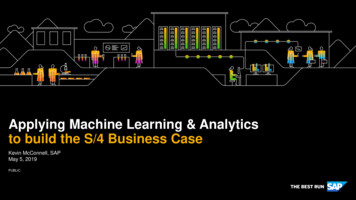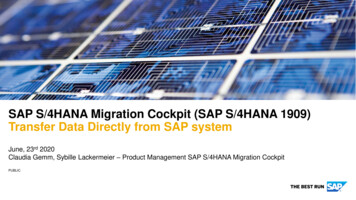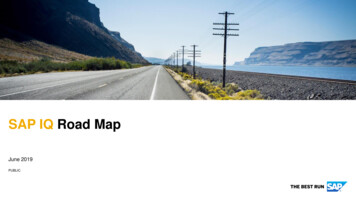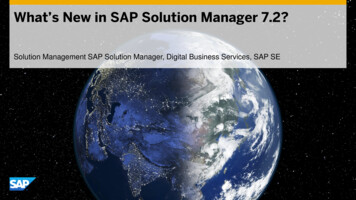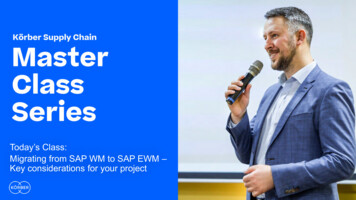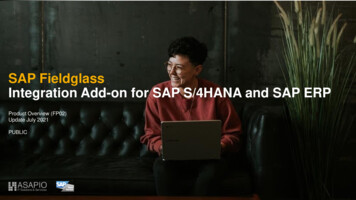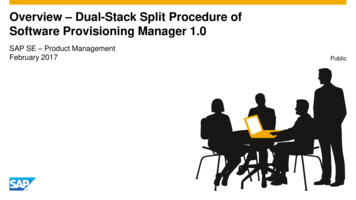
Transcription
Overview – Dual-Stack Split Procedure ofSoftware Provisioning Manager 1.0SAP SE – Product ManagementFebruary 2017Public
DisclaimerThis presentation outlines our general product direction and should not be relied on in making apurchase decision. This presentation is not subject to your license agreement or any other agreementwith SAP. SAP has no obligation to pursue any course of business outlined in this presentation or todevelop or release any functionality mentioned in this presentation. This presentation and SAP'sstrategy and possible future developments are subject to change and may be changed by SAP at anytime for any reason without notice. This document is provided without a warranty of any kind, eitherexpress or implied, including but not limited to, the implied warranties of merchantability, fitness for aparticular purpose, or non-infringement. SAP assumes no responsibility for errors or omissions in thisdocument, except if such damages were caused by SAP intentionally or grossly negligent. 2017 SAP SE or an SAP affiliate company. All rights reserved.Public2
IntroductionThe dual-stack split procedure got integrated into Software Provisioning Manager 1.0 –the procedure is no longer available as standalone toolOverall, Software Provisioning Manager 1.0 offers relevant procedures required to install, copy,and transform SAP systems in your landscape 2017 SAP SE or an SAP affiliate company. All rights reserved.Public3
Dual stack vs. single stackDefinition – what is a dual-stack system?Definition:SAP system that contains both SAP NetWeaver Application Server ABAP and Java with following characteristics: One common SAP system ID (SAPSID) One common startup framework One common databaseExamples:SAP ECC(ABAPsingle stack)SAP EnterprisePortal (Javasingle stack)SAP Process Integration(mandatory*dual stack)*) for SAP Process Integration 7.5SAP BusinessWarehouse withSAP BEx Web(optional dual stack)LegendCapability based on ABAPCapability based on JavaCapability based onABAP & JavaBI JavaEPPIEP-CAS ABAPAS Java 2017 SAP SE or an SAP affiliate company. All rights reserved.AS ABAPAS JavaBW ABAPEPAS ABAPAS JavaSingle system (SAPSID)Public4
Dual stack vs. single stackWhy decided SAP to move away from dual stack?AspectDual StackSingle StackSetup & configuration effortBackup & recovery effortSizingMonitoringSecurityAdministration / software usion Advantages for dual stack only in some areas of lifecycle managementCertain benefits can also be achieved with other meansFor other areas, tools & procedures provided on landscape levelAltogether, only some goals reached on expense of other areas 2017 SAP SE or an SAP affiliate company. All rights reserved.Public5
Dual stack vs. single stackResulting general recommendationSAP provides clear recommendations for customers how to deploy differentcapabilities based on SAP NetWeaver in a solution landscape Based on SAP’s product strategy and considering experiences from existingcustomer landscape layouts – also see previous slide General recommendation:Deploy ABAP and Java in separate systems (where possible)For more information, see, see presentation How to Deploy SAP NetWeaver –Dual Stack vs. Separated Stacks in SAP Community Network 2017 SAP SE or an SAP affiliate company. All rights reserved.Public6
Dual stack vs. single stackStatus quo: SAP Business SuiteInstallation:As of SAP Business Suite 7, you can no longer install dual-stack application systems SAP Business Suite 7 comprises SAP ERP 6.0 EHP4, CRM 7.0, SCM 7.0, PLM 7.04, SRM 7.0Upgrade/update:SAP Business Suite 7 i2011 is last SAP Business Suite release with dual-stack support –no upgrade/update of dual-stack SAP Business Suite systems to higher releases! SAP Business Suite 7 i2011 comprises SAP ERP 6.06, CRM 7.02, SCM 7.02, PLM 7.06, SRM 7.02 Other SAP-NetWeaver-based systems that have SAP Business Suite components deployed might also be treatedas SAP Business Suite systems in this regard (for more information, see SAP Note 1816819) – for example, anSAP Enterprise Portal system with SAP Business Suite business packages deployed and set up as dual-stack couldnot be upgraded to SAP NetWeaver 7.3x 2017 SAP SE or an SAP affiliate company. All rights reserved.Public7
Dual stack vs. single stackStatus quo: other systems based on SAP NetWeaverInstallation:As of SAP NetWeaver 7.0 Enhancement Package 1 (EHP1),you can no longer install dual-stack application systems (apart from SAP PI 7.4x) Dual stack ABAP only Java onlyUpgrade/update:SAP NetWeaver 7.31 is last release with support of optional dual-stack systems – no upgrade/update ofoptional dual-stack SAP NetWeaver and SAP Business Warehouse systems to higher releases(such as SAP NetWeaver 7.4)!Exceptions: Workarounds to install dual-stack SAP Business Warehouse 7.0 EHP1 system – see SAP Note 1181025 Dual-stack SAP Process Integration systems with a release 7.4 remain supported remain supported –for more information, see next slide SAP NetWeaver systems with product instance Mobile Infrastructure (MI) are not supported by dual-stack split procedure– SAP NetWeaver Mobile Infrastructure is not part of SAP NetWeaver 7.31 or SAP NetWeaver 7.4– Therefore, dual-stack deployments of SAP NetWeaver Mobile Infrastructure cannot be upgraded anyhow, but have to be migrated –for more information, see the Migration Guide – SAP NetWeaver Mobile 2017 SAP SE or an SAP affiliate company. All rights reserved.Public8
Dual stack vs. single stackStatus quo: SAP Process IntegrationDual-stack SAP PI systems with a release 7.4 remain supported as dual-stack systems – new installation, update and upgrade to thesereleases still supportedInstallation of SAP PI 7.5 and higher: For SAP systems based on SAP NetWeaver 7.5 and higher, dual stack no longer supported, without exception As a consequence, no dual-stack installation is offered as of SAP PI 7.5 –instead, standard installation consists of a separate ABAP a separate Java stack1– You install ‘Application Server ABAP for SAP Process Integration’: there, also Java users for AS Java forSAP Process Integration system are created and system is prepared to get connected to AS Java2– You install ‘Application Server Java for SAP Process Integration’: ‘AS Java for SAP PI’ system usesUser Management Engine (UME) of ‘AS ABAP for SAP PI‘ system that you must have installed beforeUpgrade to SAP PI 7.5 SP1 and higher: After upgrading to SAP PI 7.5, you first have to split still existing dual-stack SAP PI systems before their usageis supported – for this, dual-stack split procedure now also offered for SAP PI 7.5Alternative Option: Starting with SAP NetWeaver 7.3, there is an additional Java-only offering for main process integration capabilities called Advanced Adapter Engine Extended,covering 95% of a classical SAP PI dual-stack environment, feasible to most use cases – SAP recommends to migrate SAP PI content to single-stack objects– Due to harmonized process orchestration stack (SAP PI and SAP BPM running on same Java instance), many of ccBPM features in SAP PI can be expressed usingSAP BPM capabilities instead For more information about the migration of SAP PI content to single-stack objects, see:– SAP Help Portal: Migration of Dual-Stack Configuration Objects (“Classical Scenarios”) to Integrated Configuration Scenarios (Java-Only)– Blogs in SAP Community Network: Moving Integration Directory Artifacts from dual stack to single stack and SAP Directory Content Migration Tool 2017 SAP SE or an SAP affiliate company. All rights reserved.Public9
Dual stack vs. single stackStatus quo: SAP Solution ManagerSAP Solution Manager 7.1 systems remain supported as dual-stack systems – new installation, update and upgrade of SAPSolution Manager systems to this release still supportedInstallation:For SAP Solution Manger 7.2, no dual-stack installation is offered – instead, standard installation consists of a separateABAP a separate Java stackUpgrade:For SAP Solution Manager systems upgraded to 7.2, dual-stack split procedure is offered mandatory Figure below gives schematic overview of required activities For actual procedures and available options(including information about a simplified procedure,if you plan to migrate to SAP HANA or SAP ASE aspart of the split), see documentation Technical Pathto SAP Solution Manager 7.2 powered by SAP HANAand SAP Note 2227300ABAPABAPJava1AnyDB7.1SolutionManager 2017 SAP SE or an SAP affiliate company. All rights anager(SOLMAN sage7.2SolutionManagerPublic10
Dual stack vs. single stackStatus quo: SAP HANASAP HANA does not support dual stackDual-stack split is prerequisite for migration of existing dual-stack systems to SAP HANA 2017 SAP SE or an SAP affiliate company. All rights reserved.Public11
Dual stack vs. single stackDual-stack split procedure1 Separation of Java stackSeparation of Java stack out ofdual-stack source system intonew system– Export of Java stack file system– Optional deactivation of Java insource system– Installation of target Java systemwith exported load 2017 SAP SE or an SAP affiliate company. All rights reserved.2 Post-split activitiesRe-configuration, such as oftechnical connectivity betweenABAP and Java – automated forcertain use cases/product versions3Removal of Java stackfrom source system Removal of Java-related SAPsystem information within sourcesystem Can optionally be used to onlyremove Java stack (without split)Public12
Dual-stack splitAvailable via the Software Logistics Toolset 1.0 (SL Toolset)Dual-stack split procedure is offered by Software Provisioning Manager 1.0(integrated as of SL Toolset 1.0 SPS09, no longer offered standalone)Software Provisioning Manager 1.0 is delivered in regular intervals, independent from SAP applicationproduct shipments via Software Logistics Toolset, a central collection of software logistics tools, alwaysup to date: SL Toolset is the central place in SMP download area to find & download SL tools Toolset and tools updated regularly, product-independent, downward-compatible Updates include new tools as well as recent improvements & enhancementsFor more information and download, see SAP Support Portal at:http://support.sap.com/sltoolset (incl. direct download links for comprised tools)SAP recommends that you download the latest Support Package of the tool,as it contains latest corrections and is updated regularly! 2017 SAP SE or an SAP affiliate company. All rights reserved.Public13
Further informationFor more information on Software Provisioning Manager 1.0: SAP Release Note: SAP Note 1680045 Software Provisioning Manager 1.0 in SAP Community NetworkFor more information on dual-stack split procedure: Dual-Stack Split in SAP Community Network SAP Note 1797362For more information on Software Logistics Toolset: Blog in SAP Community Network SAP Support Portal at: http://support.sap.com/sltoolset 2017 SAP SE or an SAP affiliate company. All rights reserved.Public14
SAP Idea PlaceInfluence the future of software logistics SAP Idea Place is your public channel to participate in innovation at SAP Enables you to submit ideas, collaborate on and vote for ideas, and connect with the teams that areresponsible for software logistics procedures Complements traditional channels of interaction and feedback at SAP Contribute under https://ideas.sap.com/softwarelogistics 2017 SAP SE or an SAP affiliate company. All rights reserved.Public15
Thank youContact information:Stefan JakobiSAP SE – Product Management for Cloud and Lifecycle Managementstefan.jakobi@sap.com 2017 SAP SE or an SAP affiliate company. All rights reserved.
As of SAP Business Suite 7, you can no longer install dual-stack application systems SAP Business Suite 7 comprises SAP ERP 6.0 EHP4, CRM 7.0, SCM 7.0, PLM 7.04, SRM 7.0 Upgrade/update: SAP Business Suite 7 i2011 is last SAP Business Suite release with dual-stack support - no upgrade/update of dual-stack SAP Business Suite systems to higher .



